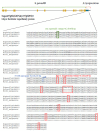Genomic Dissection of a Wild Region in a Superior Solanum pennellii Introgression Sub-Line with High Ascorbic Acid Accumulation in Tomato Fruit
- PMID: 32722275
- PMCID: PMC7466095
- DOI: 10.3390/genes11080847
Genomic Dissection of a Wild Region in a Superior Solanum pennellii Introgression Sub-Line with High Ascorbic Acid Accumulation in Tomato Fruit
Abstract
The Solanum pennellii introgression lines (ILs) have been exploited to map quantitative trait loci (QTLs) and identify favorable alleles that could improve fruit quality traits in tomato varieties. Over the past few years, ILs exhibiting increased content of ascorbic acid in the fruit have been selected, among which the sub-line R182. The aims of this work were to identify the genes of the wild donor S. pennellii harbored by the sub-line and to detect genes controlling ascorbic acid accumulation by using genomics tools. A Genotyping-By-Sequencing (GBS) approach confirmed that no wild introgressions were present in the sub-line besides one region on chromosome 7. By using a dense single nucleotide polymorphism (SNP) map obtained by RNA sequencing (RNA-Seq), the wild region of the sub-line was finely identified; thus, defining 39 wild genes that replaced 33 genes of the ILs genetic background (cv. M82). The differentially expressed genes mapping in the region and the variants detected among the cultivated and the wild alleles evidenced the potential role of the novel genes present in the wild region. Interestingly, one upregulated gene, annotated as a major facilitator superfamily protein, showed a novel structure in R182, with respect to the parental lines. These genes will be further investigated using gene editing strategies.
Keywords: RNA-Seq; Solanum lycopersicum; genome reconstruction; genotyping-by-sequencing; introgression lines; red ripe fruit.
Conflict of interest statement
The authors declare no conflict of interest.
Figures



Similar articles
-
Phenotypic and Molecular Selection of a Superior Solanum pennellii Introgression Sub-Line Suitable for Improving Quality Traits of Cultivated Tomatoes.Front Plant Sci. 2019 Feb 22;10:190. doi: 10.3389/fpls.2019.00190. eCollection 2019. Front Plant Sci. 2019. PMID: 30853967 Free PMC article.
-
Candidate genes and quantitative trait loci affecting fruit ascorbic acid content in three tomato populations.Plant Physiol. 2007 Apr;143(4):1943-53. doi: 10.1104/pp.106.091413. Epub 2007 Feb 2. Plant Physiol. 2007. PMID: 17277090 Free PMC article.
-
Uncovering tomato quantitative trait loci and candidate genes for fruit cuticular lipid composition using the Solanum pennellii introgression line population.J Exp Bot. 2017 May 17;68(11):2703-2716. doi: 10.1093/jxb/erx134. J Exp Bot. 2017. PMID: 28475776 Free PMC article.
-
An integrated view of quantitative trait variation using tomato interspecific introgression lines.Curr Opin Genet Dev. 2007 Dec;17(6):545-52. doi: 10.1016/j.gde.2007.07.007. Epub 2007 Aug 27. Curr Opin Genet Dev. 2007. PMID: 17723293 Review.
-
Trait discovery and editing in tomato.Plant J. 2019 Jan;97(1):73-90. doi: 10.1111/tpj.14152. Epub 2018 Dec 24. Plant J. 2019. PMID: 30417464 Review.
Cited by
-
Regulation of Vitamin C Accumulation for Improved Tomato Fruit Quality and Alleviation of Abiotic Stress.Genes (Basel). 2021 May 6;12(5):694. doi: 10.3390/genes12050694. Genes (Basel). 2021. PMID: 34066421 Free PMC article. Review.
-
Identification and Characterization of the StCPAI Gene Family in Potato.Plants (Basel). 2025 Aug 9;14(16):2472. doi: 10.3390/plants14162472. Plants (Basel). 2025. PMID: 40872095 Free PMC article.
-
Accelerating the Development of Heat Tolerant Tomato Hybrids through a Multi-Traits Evaluation of Parental Lines Combining Phenotypic and Genotypic Analysis.Plants (Basel). 2021 Oct 13;10(10):2168. doi: 10.3390/plants10102168. Plants (Basel). 2021. PMID: 34685977 Free PMC article.
References
-
- Yadav R., Rathi M., Pednekar A., Rewachandani Y. A detailed review on Solanaceae family. Eur. J. Pharm. Med. Res. 2016;3:369–378.
-
- Peralta I.E., Knapp S., Spooner D.M. New species of wild tomatoes (Solanum section Lycopersicon: Solanaceae) from Northern Peru. Syst. Bot. 2005;30:424–434. doi: 10.1600/0363644054223657. - DOI
-
- Peralta I.E., Spooner D. Classification of Wild Tomatoes: A Review. Kurtziana. 2000;28:145–154.
Publication types
MeSH terms
Substances
LinkOut - more resources
Full Text Sources
Medical
Miscellaneous

